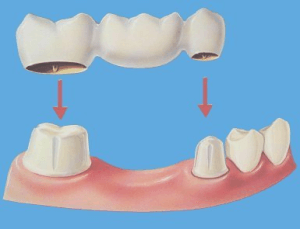For one reason or another, sometimes teeth have to come out. Either they have needed to be pulled for some reason or poor dental hygiene has caused decay to reach the point of separation of teeth from gums. Either way, missing teeth not only lowers your confidence, they make things like eating, drinking, speaking and smiling a difficult task. In this article, you will learn all about tooth bridges and their benefits. Read on to see what is a dental bridge.
What is a Dental Bridge?
A dental bridge is literally just that–a bridge made of any number of materials to bridge a gap formed by one or more missing teeth. Crowns are usually put on the teeth on either side of the gap and are used to help anchor the bridge in its final proper position.
The fake teeth that make up the bridge are known as pontics and can be made from alloys, gold, porcelain or a mixture of the three and can be matched to the color of your natural teeth. Dental bridges can be supported either by implants or natural teeth.
What Are the Benefits of Dental Bridges?
Tooth bridges come with a variety of benefits that can help you live a healthier, fuller, more confident life after losing one or more teeth. The benefits of a dental bridge include:
- The restoration of your smile so that you can confidently face your peers.
- Restoration of the ability to chew your food with ease and speak properly.
- Maintaining your facial shape that may have been altered by the loss of teeth.
- More even distributing of the force in your bite.
- Prevention of the remaining natural teeth from moving out of their designated positions.
How Long Do Crowns and Bridges Last?
While crowns and dental bridges can indeed last an entire lifetime, sometimes they can come loose or fall out completely. The best thing you can do to ensure that your dental bridge lasts is to practice good oral hygiene. A dental bridge loses support when the teeth or bone keeping it in place is damaged by a dental disease.
It is important to keep your teeth and gums healthy with proper brushing using fluoride toothpaste a minimum of twice daily and using floss a minimum of once a day. It is also important that you schedule regular checkups with your dentist for professional cleaning. Also, avoid chewing hard foods or ice when adjusting to your new tooth bridge.
Types of Dental Bridges
- Traditional dental bridge. A traditional dental bridge involves making a crown for the implant or natural tooth on either side of the missing tooth, putting a pontic in the middle. These are the most popular dental bridges and are composed of ceramics or porcelain fused to metal.
- Cantilever dental bridge. It is used when there are nearby teeth on only one side of the missing tooth. This is not a common bridge anymore and is no longer recommended for the back of the mouth where too much force can be placed upon it, causing damage to nearby natural teeth.
- Maryland bonded dental bridge. Also known as a resin-bonded bridge or just a Maryland bridge, this dental bridge type is made of porcelain, porcelain fused to metal, or plastic teeth and gums held up by porcelain or metal. Porcelain or metal wings are often on just one side of the bridge and are bonded to the existing teeth.
What Is the Process for Getting a Dental Bridge?
- On the first visit, the anchoring, or abutment, teeth are prepared by re-shaping these teeth, removing a portion of the enamel to give room for a crown to be put on them.
- Impressions of the teeth are then taken so that there is a model for the pontic, crowns and bridge to be made in a dental lab.
- On the second visit, your dental bridge will be adjusted and checked as necessary to ensure a proper fit. A few visits may be required to check the fit of the bite and framework.
- When the dental bridge receives its final adjustment, it will be cemented into place.
A tooth bridge is something that bridges the gap of missing teeth. Anchored to the surrounding teeth, it can be made of porcelain, porcelain fused to metal or alloys–sometimes even all three. They can last a lifetime with proper care, and the benefits of getting a bridge are numerous. The process of application is rather simple, so if a missing tooth affects your life, consider getting a dental bridge.
Do you wear a dental bridge? How has it positively affected your life? What was it like having it installed? Share your experience with us in the “Comments” section!



Leave a Comment